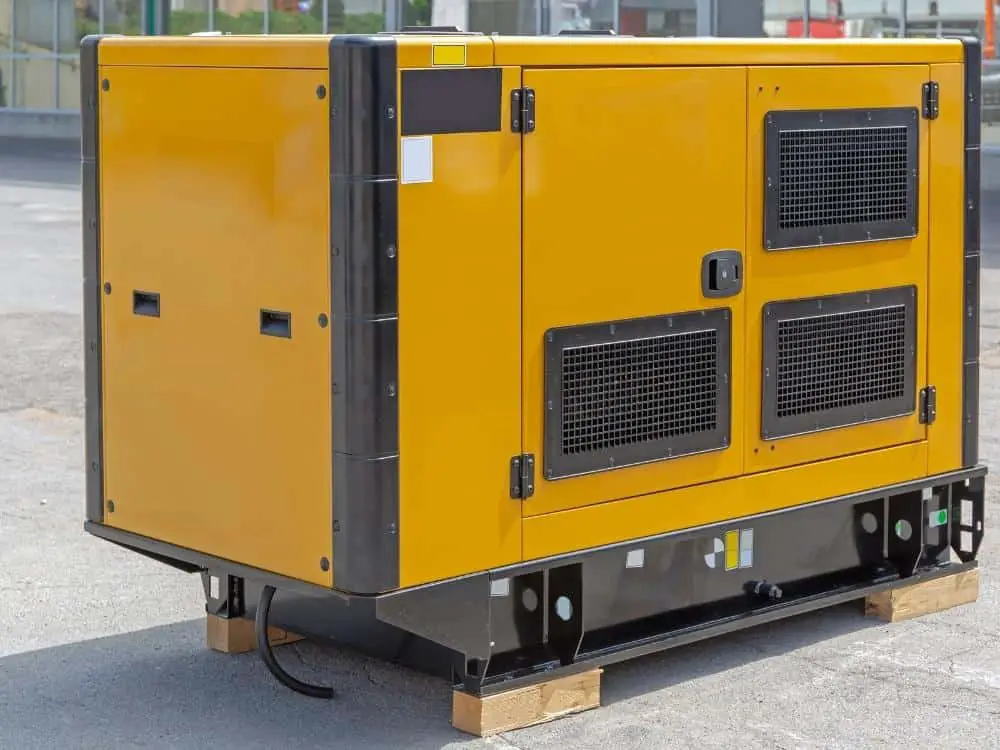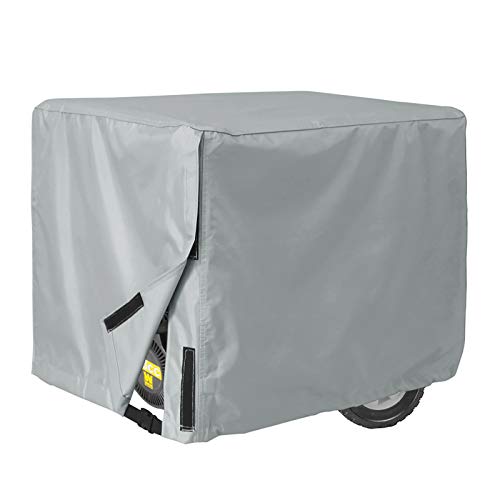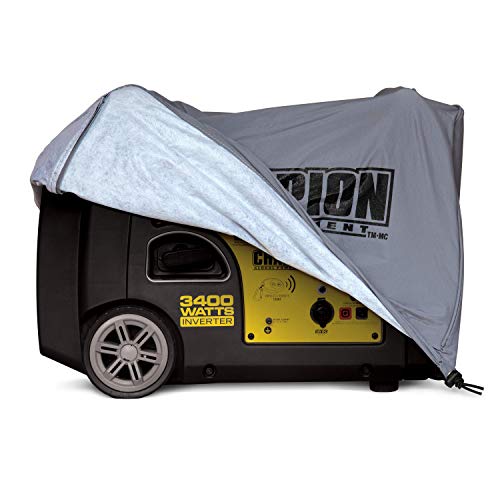Portable generators may be used for various purposes, including emergency and entertainment. For example, many RV campers carry portable generators to unpowered campgrounds, and during a storm, a portable generator may be a lifeline. However, with that in mind, can a generator get wet?
As with other electrical appliances in your home, never expose your generator to water as this can result in sparking, fires, and electrocution. Even heavy dew or floodwater can cause a generator to get wet. Thus, generators should not be used in wet weather conditions.
To determine whether a generator can get wet, we need to consider the following:
- Are generators capable of running in wet weather conditions
- What the best covers for generators for storage and outdoor use are
- What the different types of generator enclosures are
- Other factors to keep in mind when using a generator
- How to take care of a wet generator
However, portable generators can be challenging to run securely in harsh weather when they are most beneficial or required. Fortunately, several secure methods ensure that you and your generator don’t succumb to a dangerous situation during a storm. In light of that, let’s first consider if a generator can operate in wet weather conditions.

Can Generators Run In Wet Weather Conditions?
A portable generator uses fuel, propane, or batteries to generate energy. The output of most portable devices is provided via a 220-volt or 110-volt outlet. Like the ones in your home, this outlet should never be damp since it can cause catastrophic results. In addition, floodwater, blown-in rain, or even heavy dew might get a generator wet.
In general, using a generator in wet weather is not a good idea and should be avoided. If there is bad weather, try to wait it out and only use the generator once the weather has passed. You may, however, find yourself needing to operate a generator in the rain.
As a result, the short answer is yes; you may operate a generator in the rain as long as you have a proper cover to keep it dry. However, it would be best to use considerable caution, as it is still not advised.
It is necessary to cover or enclose a generator to run it safely in the rain. However, the generator requires adequate air circulation to avoid overheating and the accumulation of carbon monoxide emissions.
Therefore, not all covers or enclosures are suitable. Additionally, the generator should be placed on a level, dry surface.
Under most generators, the surface change under the generator should be less than 15 degrees in all directions. It is often enough to raise a generator off the moist ground with a flat piece of plywood.
The Best Generator Covers For Storage Or Outdoor Use
Generators are handy in the case of a power outage since they generate energy, which offers light and heat. On the other hand, a generator is only beneficial if it is ready to use when calamity hits.
Protecting a generator with a cover that shields it from weather that might decrease its life, such as rain and snow, is one of the best methods to guarantee it remains in top operational shape.
Waterproof materials such as 600-denier polyester, vinyl, and tarpaulin are used to make generator covers. Some covers are meant to protect the generator from the elements while it is not in use, while others are designed to protect it while running.
With that in mind, starting with the GenTent Running Cover, let’s take a look at some of the best generator covers to use during those rainy or snowy seasons.
GenTent Generator Running Cover
Though it is an investment, this generator cover’s creative design and durability make it one of the finest solutions for providing total protection for a generator when in use or storage. The cover is made of flame-retardant, marine-grade vinyl and works with open-frame generators.
The cover is supported by a solid steel pole, making it strong enough to withstand 70 mph winds and 18 inches of snowfall. Vents on the top of the body and a retractable skirt provide plenty of air while the generator is working and maximum protection when the generator is turned off.
- Safely run your portable generator outside in any wet weather - rain, snow, ice, sleet, and wind.
- Waterproof and sheds water away, protecting sensitive electrical areas, large door for easy refuel.
- Universal running cover for open frame generators with perimeters ranging from 76"-104".
In addition, the top of the cover opens, allowing full access to the generator’s controls and gas tank. The GenTent fits most portable generators ranging from 3,000 to 10,000 watts, measuring 36 inches long by 24 inches broad.
Porch Shield Waterproof Universal Generator Cover
This cover is made of 600-denier material with a waterproof underlayment to protect portable generators placed outside. The box-shaped cover, which comes in various sizes, fits around the generator and has sides that extend to the ground, offering complete protection.
Even in heavy gusts, an elastic hem and plastic buckles keep the cover in place. The user may reach the generator handle by flipping up a flap kept in place on the sides with Velcro, which allows the operator to adjust it without removing the cover.
- Generator cover is made of 600D durable polyester fabric with an added water-resistant laminated undercoating. 5 Sizes available. Can be used in...
- Water-resistant backing keeps your generator completely dry. And full cover with seam sealing tape make it 100% waterproof.
- Two stacks of fabric at one side make the cover weather resistant, but ventilated. Velcro at another side allow easy install and remove.
It’s simple to match the cover to the house’s exterior with four color options: black, light tan, khaki, and gray. This cover is only for storing purposes.
Champion Weather-Resistant Storage Cover
This closed-frame cover is perfect for covering compact inverter-style generators due to its modest size. It fits most 1,200 to 1,875-watt generators with dimensions of up to 18.9 inches long, 15.8 inches broad, and 14.2 inches tall, while alternative sizes are available.
The cover is made of tough waterproof vinyl that conforms to the generator when closed and has a lenient cotton lining on the inside to protect it from scratches.
No products found.
In heavy winds or at the back of a pickup truck, an elastic drawstring across the bottom of the generator holds the cover securely in place.
Therefore, the Champion generator cover should only be used for storage and removed when the generator is running.
What Types Of Generator Enclosures Are There?
The fundamental functions of all enclosures are to protect and help silence a generator. When you are in the market for a generator enclosure or have the right tools for a DIY, there are four options to consider: A baffle box, a wooden enclosure, a galvanized steel enclosure, and a concrete enclosure.
Because moisture and severe temperatures are a generator’s biggest threats, weather-resistant enclosures are designed and manufactured to keep them safe from the elements – some do it better than others.
You may make several DIY generator enclosures out of a range of materials. These come in various sizes and designs, ranging from small boxes to walk-in sheds, and are available at a variety of pricing ranges. Here are a few examples of generator enclosures that you may construct:
- Baffle box for soundproofing
It is also known as a sound-attenuating silent box and reduces noise in the surrounding environment. It works best when sound-absorbing materials such as mass-loaded vinyl, medium-density fiberboard, acoustic caulking, and green glue sealant are used to line them.
- A DIY wooden enclosure
A timber enclosure in a flat-topped, asymmetrical lean-to with shingles, peaked or gabled, or another form can be created for a low cost. Plans with several hinged or sliding doors or lids should be included.
- An enclosure made of galvanized steel
This building is made of galvanized steel sheets. Therefore, it’s especially critical that metal constructions have enough hinged apertures to allow for optimal ventilation.
- An enclosure made from concrete blocks
A construction made of concrete blocks that have been mortared together is particularly strong, soundproof, and secure. However, it also necessitates extra caution in terms of access and ventilation.
What Not To Do With A Portable Generator
Operating a portable generator in heavy rain or hurricane conditions may be extremely dangerous, especially at a cold, damp campground. If vital elements of the generator become wet, the implications can vary from malfunction to explosions and fatalities.
So with that as an eyeopener, you may wonder what else to keep in mind. As a result, here are five additional factors to take into consideration.
1. Don’t run the generator too close to the house.
If you have a fixed generator, it should be properly installed as far away from your property as the manufacturer’s instructions and local laws permit (usually 20 feet). An odorless, invisible gas, carbon monoxide, may be lethal to a portable device.
It should be kept away from any doors or windows. Even if the garage doors are open, as tempting as it may be, never run it in there. A portable generator’s instructions state that it should not be used in the rain.
Instead, I suggest using it on a dry area beneath an open, canopy-like structure or a recommended generator cover to keep it dry.
2. Don’t overuse the extension cords.
Many goods, including extension cables, become scarce when a storm strikes. Unfortunately, this implies that you’ll have to rely on cords that are potentially years old and hazardous for the equipment you’re connecting.
A transfer switch with an outside power intake should be installed if your generator has a 220-volt outlet, so you only have to worry about one safe connection instead of many.
If your generator is tiny and doesn’t have a 220-volt outlet, your only option is to use extension cables. As a result, stock up on 12-gauge extension cables, which can handle most 110-volt appliances.
3. Direct access to your service panel
Ranges and heating/cooling systems that are hard-wired to your service panel do not have connectors to connect to the generator. As a result, the desire to connect the generator directly to the service panel may grow.
What is the risk? The surplus might run back up the line when the power is restored, putting utility personnel at risk.
4. Putting fuel considerations aside
Before purchasing a generator, you should consider available fuel and consider the clogged highways, shuttered gas stations, gas rationing, and other issues that some people are currently dealing with due to major power outages.
So, whether your generator runs on gasoline, diesel, or propane, you’ll need plenty on hand when a storm strikes. You should be good with a stationary device utilizing natural gas.
Most portables require 8 to 22 gallons of gasoline per day, whereas portable models use four to eight 20-pound propane tanks per day. A 250-gallon propane tank can last 8 to 15 days for fixed devices. On the other hand, a gasoline unit must be turned off and allowed to cool before refilling.
Keep in mind what component of the gasoline ignites the fumes; it might be microscopic gas droplets. The gasoline droplets become mixed together with the air and form fumes.
Finally, allow at least 10 minutes for your generator to cool down before filling it. Also, never stand on the hot side of a muffler while it’s refilling; it’s hazardous. Splashing gas on a running generator’s hot exhaust, near the spark plug, or elsewhere might quickly ignite a fire.
5. Maintenance is a must
Your owner’s handbook will tell you how frequently to replace the oil and which one to use, as well as how to do it after the first few hours of usage. If your generator runs on gasoline, add a stabilizer before filling it up to minimize long-term fuel storage.
You may dump unused gasoline into your car’s gas tank every six months and start again with fresh stabilized fuel. However, while skipping regular maintenance may not cause your generator to fail, skipping them too often may cause it to fail to start or seize.
What To Do If Your Generator Does Get Wet
If you try to plug or unplug goods when they’re wet, you risk getting shocked or electrocuted. Therefore, make sure the generator has completely dried out before using it if you suspect it is wet.
When a generator gets wet, it’s not always as simple as fetching a towel and gently rubbing it until it’s entirely dry, then rewarding it with a treat if it wags its tail.
Jokes aside, you’ll need to consider how it got wet. Did it get wet from seawater or freshwater? If exposed to seawater, it must first be washed with fresh water or suffer severe long-term damage and be scrapped.
Freshwater infiltration isn’t too awful if you dry off the afflicted regions thoroughly and keep the unit electrically disconnected during the process. After disconnecting the wet generator and stopping its start function, open up the afflicted area and dehumidify the interior with hot, dry air.
You’re attempting to re-establish a high level of insulating resistance to the earth and between phases, so everything must be completely dry and clean. A simple hair drier can do for a smaller generator.
Still, larger generators will need a larger drying blower to provide the appropriate heat and airflow into the required locations.
In addition, to restore the machine’s insulating value, you may need to blast hot, dry air through it for several hours.
References
- https://www.consumerreports.org/cro/news/2012/11/5-generator-mistakes-that-can-leave-you-in-the-dark-or-worse/index.htm
- https://homeguides.sfgate.com/protect-portable-generator-rain-37629.html
- https://www.generac.com/resources-and-tools/homeowner-resources/portable-generator-safety
- https://howtodiscuss.com/t/can-a-generator-get-wet/144777









